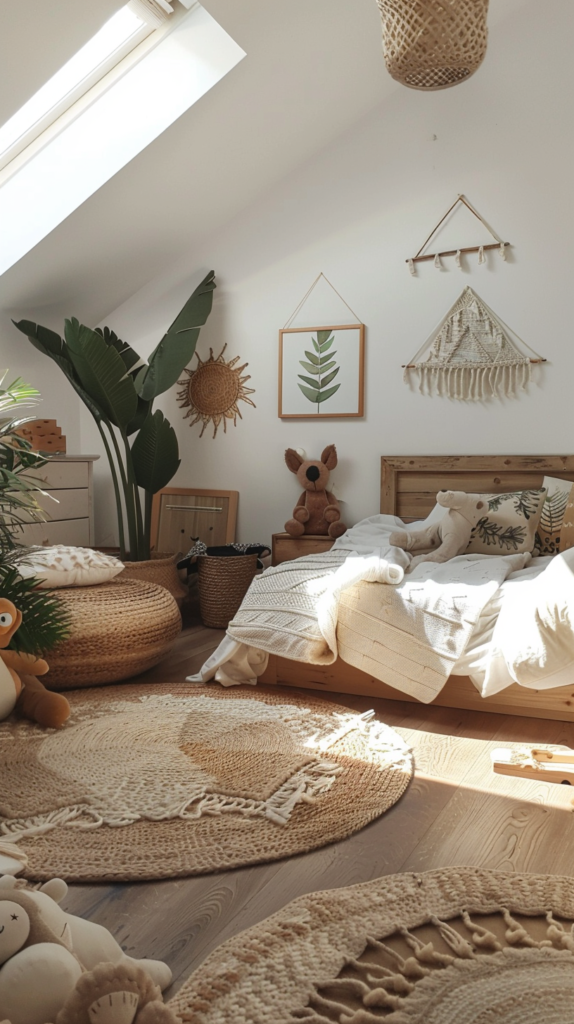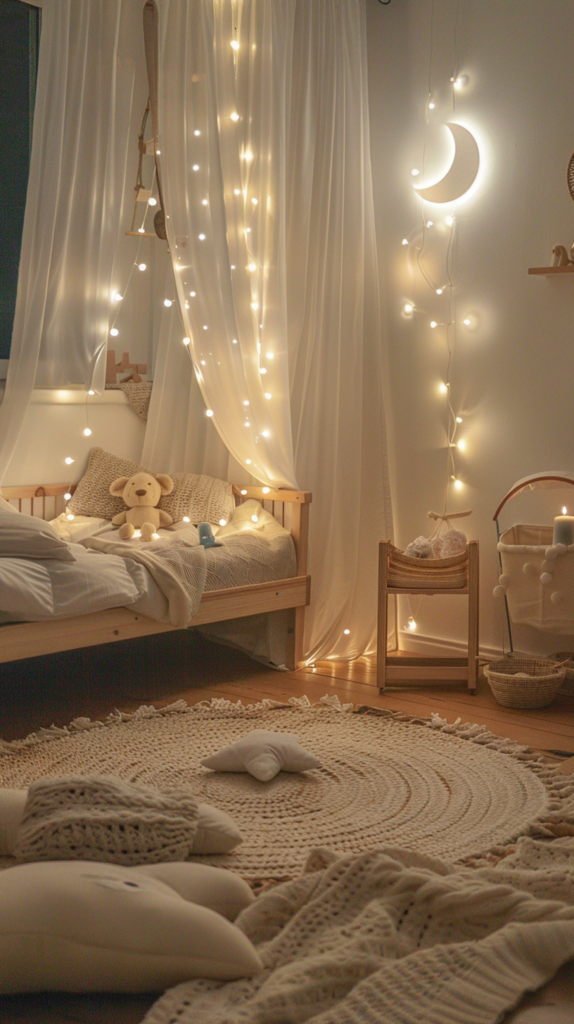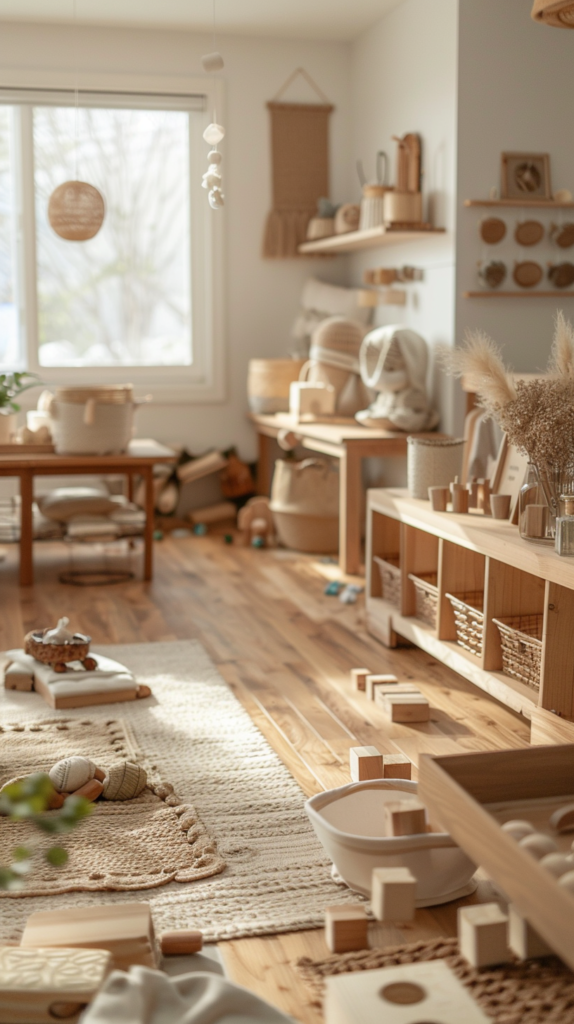Disclosure: Some links on this site are affiliate links. As Amazon Associates, we earn from qualifying purchases (at no cost to you).
Montessori-inspired toddler rooms are designed to foster independence, creativity, and a love of learning in young children. These rooms emphasize simplicity, accessibility, and natural materials to create an environment that encourages exploration and self-directed activity.
Here are 18 Montessori toddler room ideas to inspire your next decor project.
1. Low Shelves for Accessibility
Low shelves are a staple in Montessori toddler rooms. Place shelves at your child’s height to allow them to independently access toys, books, and activities. Opt for open shelving units made from natural wood to keep the room looking organized and inviting.

This setup encourages toddlers to choose their activities, learn to take responsibility for tidying up, and develop a sense of ownership over their environment. The visibility of each item on the shelf also helps children understand the concept of order and categorization.
2. Floor Bed for Independence
A floor bed is a key element in a Montessori bedroom. Use a low mattress on the floor instead of a traditional crib to give your toddler the freedom to get in and out of bed independently. This setup promotes a sense of autonomy and helps toddlers learn to regulate their sleep patterns.

It also encourages them to explore their room and engage in activities as soon as they wake up, fostering a seamless transition between rest and play.
3. Montessori Learning Tower
A Montessori learning tower is a great addition to any toddler room. This adjustable step stool allows your child to safely reach higher surfaces like kitchen counters or bathroom sinks.

It’s perfect for encouraging participation in daily activities such as cooking, washing hands, or brushing teeth, fostering independence and practical life skills. The learning tower can also be used in the bedroom for activities such as watering plants or organizing their belongings.
4. Natural Materials
Incorporate natural materials like wood, cotton, and wool in your toddler’s room. Choose wooden furniture, cotton bedding, and wool rugs to create a warm, inviting space that connects your child with the natural world.

Natural materials are also typically more durable and safer for children, as they are free from harmful chemicals often found in synthetic products. Additionally, the use of natural materials can create a calming and aesthetically pleasing environment.
5. Minimalist Decor
Montessori rooms emphasize simplicity. Keep decor minimal with a focus on functionality. Avoid clutter and choose a few high-quality toys and learning materials. This approach helps reduce overstimulation and allows your child to focus on their activities.

Minimalist decor also makes it easier to maintain a clean and organized space, which can contribute to a sense of calm and order in your toddler’s daily routine.
6. Child-Sized Furniture
Furniture scaled to your toddler’s size is essential. Include child-sized tables, chairs, and storage units to enable your child to comfortably and independently use their space. This promotes self-reliance and ensures everything is within easy reach.

Child-sized furniture also supports proper posture and ergonomic comfort, making it easier for your child to engage in activities for extended periods.
7. Art Display Area
Create a space to display your toddler’s artwork. Use low-hanging picture frames, corkboards, or a string with clips to showcase their creations.

This not only boosts their confidence and self-esteem but also encourages them to continue exploring their artistic talents. Having an art display area also helps personalize the room and makes it feel like a space that truly belongs to them.
8. Nature-Inspired Decor
Bring elements of nature into your toddler’s room to stimulate their senses and curiosity. Incorporate items like potted plants, nature-themed artwork, and natural textures.

These elements can create a soothing environment and foster a connection to the natural world. For instance, a small indoor garden or a collection of natural treasures like stones and shells can serve as both decor and educational tools.
9. Montessori Work Space
Designate a specific area for focused activities and learning. Set up a small table and chair where your child can engage in puzzles, drawing, or other educational activities.

Ensure this area is well-lit and free from distractions to create an ideal learning environment. Having a dedicated workspace helps establish a routine and encourages concentration and productivity.
10. Soft Lighting
Soft, adjustable lighting can make a significant difference in creating a calming atmosphere. Use dimmable lights, fairy lights, or lamps with soft hues to provide gentle illumination.

This type of lighting can be soothing and help your toddler wind down before bedtime. Additionally, it can create a cozy ambiance that makes the room feel safe and inviting.
11. Accessible Clothing Storage
Encourage independence in dressing with accessible clothing storage. Use low-hanging rods, open shelves, and easily accessible drawers to allow your child to choose their outfits.

This setup fosters decision-making skills and gives your toddler a sense of control over their daily routine. It also helps teach organizational skills as they learn to put away their clothes properly.
12. Quiet Corner
Create a quiet corner where your toddler can relax and unwind. Set up a cozy nook with soft cushions, blankets, and a few favorite books.

This space can serve as a retreat for your child when they need a moment of calm or a break from more stimulating activities. Having a designated quiet corner can help them learn to manage their emotions and practice self-soothing techniques.
13. Rotating Toys and Books
To keep your toddler engaged and prevent boredom, consider rotating their toys and books. Keep a selection of items out on display and store the rest away. Every few weeks, swap the items to keep things fresh and interesting.

This approach not only keeps the room tidy but also stimulates your child’s curiosity and interest in their belongings.
14. Personalized Decor
Incorporate personalized decor elements to make the room feel unique and special. Use items like custom name signs, monogrammed pillows, or family photos.

Personalized touches can make the room feel more personal and help your child develop a sense of identity and belonging. They also add a warm, loving touch to the decor.
15. Mirror at Child’s Height
Install a mirror at your child’s height to promote self-awareness and independence. Choose a safe, shatterproof mirror and secure it to the wall.

This allows your toddler to see themselves as they dress, play, and interact with their environment, fostering a sense of self and body awareness. It can also be a tool for practicing expressions and emotions.
16. Educational Wall Art
Decorate the walls with educational art that stimulates learning. Use posters, prints, or decals featuring numbers, letters, animals, or maps.

These visual aids can serve as learning tools and add an educational element to the decor. Educational wall art can spark curiosity and provide opportunities for impromptu lessons and discussions.
17. Open Floor Space
Ensure there is plenty of open floor space for movement and play. Arrange furniture in a way that maximizes floor space and allows for free movement.

This encourages active play, which is essential for your toddler’s physical development. An open floor space also provides a blank canvas for your child to engage in imaginative play and exploration.
18. Montessori-Inspired Play Area
Create a dedicated play area with Montessori-inspired toys and activities. Include items like wooden blocks, sensory bins, and practical life tools.

This area should be easily accessible and inviting, encouraging your toddler to engage in purposeful play. Montessori-inspired toys are designed to promote fine motor skills, problem-solving, and creativity.
Final Thoughts
Designing a Montessori toddler room is all about creating an environment that supports your child’s independence, learning, and creativity.
By incorporating elements like low shelves, natural materials, and child-sized furniture, you can create a space that fosters growth and exploration.
Use these 18 ideas as inspiration to transform your toddler’s room into a nurturing and stimulating environment that supports their development. Happy decorating!


